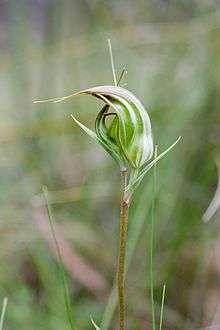Pterostylis aestiva
Pterostylis aestiva, commonly known as the long-tongued summer greenhood, is a species of orchid endemic to south-eastern Australia. As with similar greenhoods, the flowering plants differ from those which are not flowering. The non-flowering plants have a rosette of leaves flat on the ground but the flowering plants have a single flower with leaves on the flowering spike.
| Long-tongued summer greenhood | |
|---|---|
 | |
| Pterostylis aestiva growing in Namadgi National Park | |
| Scientific classification | |
| Kingdom: | Plantae |
| Clade: | Tracheophytes |
| Clade: | Angiosperms |
| Clade: | Monocots |
| Order: | Asparagales |
| Family: | Orchidaceae |
| Subfamily: | Orchidoideae |
| Tribe: | Cranichideae |
| Genus: | Pterostylis |
| Species: | P. aestiva |
| Binomial name | |
| Pterostylis aestiva | |
| Synonyms[1] | |
Description
Pterostylis aestiva is a terrestrial, perennial, deciduous, herb with an underground tuber and when not flowering, a rosette of dark bluish-green leaves, each leaf 10–30 millimetres (0.4–1 in) long and 10–15 millimetres (0.4–0.6 in) wide. Flowering plants have a single flower 20–30 millimetres (0.8–1 in) long and 7–9 millimetres (0.3–0.4 in) wide borne on a spike 150–350 millimetres (6–10 in) high with between three and five stem leaves. The flowers are dark bluish-green, white and brown. The dorsal sepal and petals are fused, forming a hood or "galea" over the column. The dorsal sepal curves forward with a thread-like tip 8–12 millimetres (0.3–0.5 in) long. The lateral sepals are held closely against the galea, have an erect, thread-like tip 25–35 millimetres (0.98–1.4 in) long and a protruding sinus between their bases. The labellum is 15–19 millimetres (0.6–0.7 in) long, about 4 millimetres (0.2 in) wide, brown, blunt, and curved and protrudes above the sinus. Flowering occurs from January to April.[2][3][4]
Taxonomy and naming
Pterostylis aestiva was first formally described in 1972 by David Jones from a specimen collected near Wulgulmerang. The description was published in Muelleria.[1][5] The specific epithet (aestiva) is a Latin word meaning "pertaining to summer".[6]
Distribution and habitat
The long-tongued summer greenhood grows among grasses in high rainfall forests in north-east Victoria and New South Wales as far north as Mount Canobolas.[2][3][4]
Use in horticulture
This greenhood is easily grows in pots although plants must be kept moist during the growing season and dry when dormant.[7]
References
- "Pterostylis aestiva". APNI. Retrieved 2 May 2017.
- Jones, David L. (2006). A complete guide to native orchids of Australia including the island territories. Frenchs Forest, N.S.W.: New Holland. p. 294. ISBN 978-1877069123.
- Jones, David L. "Pterostylis aestiva". Royal Botanic Garden Sydney: plantnet. Retrieved 2 May 2017.
- Jeanes, Jeff. "Pterostylis aestiva". Royal Botanic Gardens Victoria: vicflora. Retrieved 2 May 2017.
- Jones, David L. (1972). "A new species of Orchidaceae from Victoria" (PDF). Muelleria. 2 (3): 151–154. Retrieved 2 May 2017.
- Brown, Roland Wilbur (1956). The Composition of Scientific Words. Washington, D.C.: Smithsonian Institution Press. p. 72.
- "Australian terrestrial orchids". The Orchid Society of New South Wales. Retrieved 2 May 2017.